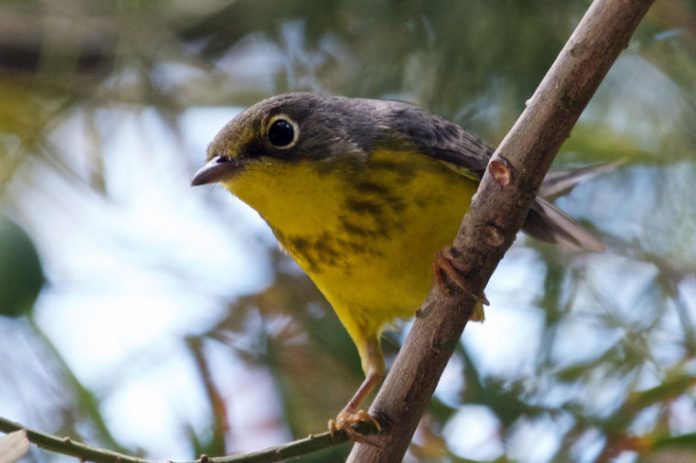Every September I look for the white-crowned sparrows to arrive. A small flock takes up residence each fall in an overgrown Lady Banks rose that covers the side of my neighbor’s garage. They join the house finches, chestnut-backed chickadees and lesser goldfinches at my feeders. White-crowned sparrows are distinctive, with a narrow white stripe on the top of their heads, black stripes on either side of the white “crown” and broad white eyebrows.
They are just one of a number of species that call the Santa Clara Valley home for the winter. Soon the American goldfinches will arrive too. Pale yellow lesser goldfinches are residents year round, but the vividly colored American goldfinches only winter with us. Their bright yellow bodies contrast with very dark wings and a black forehead. You can attract them to your yard by putting out nyjer seed, a tiny seed also called thistle seed, but does not sprout thistles. Or, says Freddy Howell, owner of Los Gatos Birdwatcher, try sunflower seed chips to attract all finches.
Cedar waxwings will also be showing up. Sightings have been reported in east San Jose, and if they aren’t here yet, they will be soon. These are very striking birds, about the size of a plump robin, with yellow brown feathers on the breast, a dark crest and a black mask. The tip of the tail is yellow and there is a distinctive red spot on the wings. They gather in flocks, often in pyracantha or toyon bushes, eating berries. If the berries are past their prime, the birds often get tipsy. WERC took in an inebriated cedar waxwing several years ago. After he dried out and could fly straight, he was ready for release (with a stern warning, of course) back to a flock of his own kind.
Recently being seen in large flocks is a particularly lovely little bird: the yellow warbler. Often spotted munching insects and berries at the tops of eucalyptus trees, they are unmistakable with their bright yellow feathers and reddish streaks on the breast. Other migratory warblers, including the Virginia’s warbler, the Canada warbler and the Tennessee warbler, have recently been spotted in Sunnyvale.
Birders are abuzz about the numbers of Swainson’s hawks being seen in Coyote Valley. Historically, Swainson’s were fairly common in this area, but in past years had largely disappeared due to increasing urbanization of farmland. The past two winters, however, have seen increasing numbers of Swainson’s. Craige Edgerton, an avid birder and executive director of the Silicon Valley Land Conservancy, reports that on one day last winter, he spotted 15 individual Swainson’s hawks along Laguna Avenue. You might see one of these hawks soaring above the valley this year. They are similar in size to our familiar, year-round red-tailed hawks, but have longer, narrower wings and generally a dark colored breast.
Joining the Swainson’s hawks in Coyote Valley are the Ferruginous hawks, which are our largest hawks and look white when seen from below.
About a month ago I was thrilled to spot one of the first bald eagles this year in the South County. It flew onto a utility pole just north of Edmundson Avenue in Morgan Hill. More will arrive from Alaska in the next month, and some will nest here. There is a known nesting site near Casa de Fruta, which birders will be watching with anticipation. Bald eagles mate for life and pairs often return to the same nest for many years.
I would be remiss if I did not mention the ducks, geese and other water birds that will arrive soon. White pelicans can often be seen on the Ogier Ponds, north of Morgan Hill. Our usual resident population of Canada geese will explode with migrants, and other geese, including snow geese and Ross’s geese will join them. Our mallards are here year round, but soon we will also see Northern pintails, Northern shovelers (with their unique spoon-shaped bill for scooping up bugs from the bottom of the pond), green-winged teals, cinnamon teals, scaups, buffleheads and seemingly a zillion more.
Lastly, blue footed boobies have arrived! These blue-footed shore birds, not seen here for decades, come from the Galapagos and areas far south of us. It is believed they may be here because of the exploding population of anchovies in Monterey Bay. The anchovy population has also attracted an extraordinarily large number of humpback whales.
Fall and winter are excellent times to look for birds in your neighborhood. Go for a walk in the woods, explore any pond or marsh or take a day trip to the beach and try to spot an unusual visitor.










